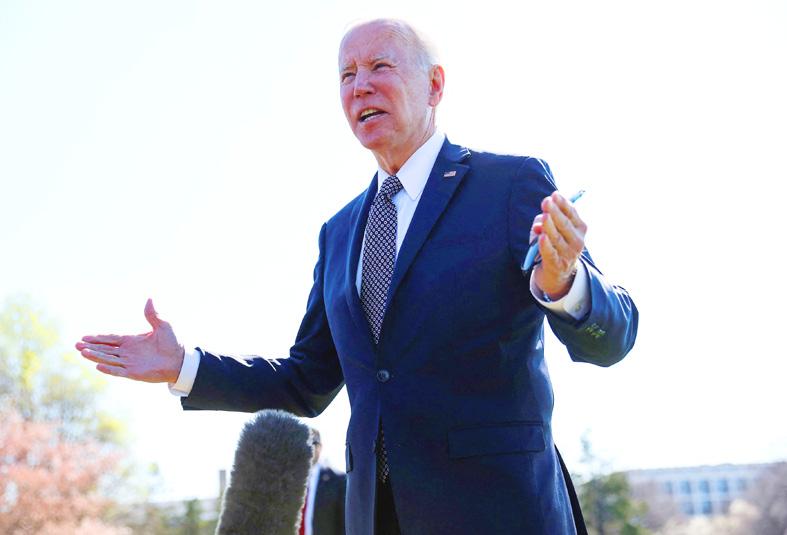The US Department of the Treasury has halted US dollar debt payments from Russian government accounts at US financial institutions as the country’s troops stand accused of committing war crimes in Ukraine.
The Treasury’s Office of Foreign Assets Control will no longer permit any US dollar payments to be made from Russian government accounts at US financial institutions, said a spokesperson for the department who discussed details of the decision on condition of anonymity.
The move is designed to force Russia into choosing among three unappealing options, the person said: Draining the US dollar reserves it holds in its own country, spending new revenue it collects, or going into default.

Photo: Reuters
The policy change comes as a payment on the country’s sovereign debt was due on Monday and is intended to further ratchet up pressure on Russian President Vladimir Putin to give up his invasion of Ukraine. It follows accusations over the weekend that Russian troops massacred civilians in Bucha and other Ukrainian towns.
The department issued a general license on March 2 that allows people in the US to receive bond payments from the central bank of Russia through May 25. Russia can still receive payments for oil and gas, as sanctions imposed on the country by the US and its allies exclude energy transactions, an exception that is set to hand Putin a US$321 billion windfall this year if the commodities continue flowing.
Russia’s central bank last week said that its foreign currency and gold reserves plunged to just US$604.4 billion as of March 25, the lowest level since August last year.
It marks a US$38.8 billion plunge since a February peak, underscoring the drain for Russia since it began the invasion.
The war prompted sweeping sanctions and handcuffed the central bank after the seizure of an estimated two-thirds of its reserves. Although central bank Governor Elvira Nabiullina has acknowledged that the curbs imposed on the Bank of Russia meant it could not intervene in the market, she has said it sold foreign currency to support the ruble on Feb. 24, when the invasion began, and the following day.
Russia has been working in the past few years to remove the US dollar’s hold over its economy and financial markets, which means it has hacked its holdings of US Treasuries and taken US dollar assets from its sovereign wealth fund.
Despite warnings from credit-rating companies and others, Putin’s government has so far stayed current on its foreign debt obligations — many of which have been relatively small when compared to the nation’s full debt load. A once-US$2 billion bond that matured on Monday served as the most recent debt stress test, although Russia was able to buy back about three-quarters of the outstanding amount in rubles before the note came due.
Up next will be payments on May 27 for interest owed on sovereign US dollar and euro notes due in 2026 and 2036, data compiled by Bloomberg show.
The department has said that no decision has yet been made regarding the May 25 expiration of the general license allowing US persons to receive debt payments from the Russian central bank.

CHIP RACE: Three years of overbroad export controls drove foreign competitors to pursue their own AI chips, and ‘cost US taxpayers billions of dollars,’ Nvidia said China has figured out the US strategy for allowing it to buy Nvidia Corp’s H200s and is rejecting the artificial intelligence (AI) chip in favor of domestically developed semiconductors, White House AI adviser David Sacks said, citing news reports. US President Donald Trump on Monday said that he would allow shipments of Nvidia’s H200 chips to China, part of an administration effort backed by Sacks to challenge Chinese tech champions such as Huawei Technologies Co (華為) by bringing US competition to their home market. On Friday, Sacks signaled that he was uncertain about whether that approach would work. “They’re rejecting our chips,” Sacks

Taiwan’s long-term economic competitiveness will hinge not only on national champions like Taiwan Semiconductor Manufacturing Co. (TSMC, 台積電) but also on the widespread adoption of artificial intelligence (AI) and other emerging technologies, a US-based scholar has said. At a lecture in Taipei on Tuesday, Jeffrey Ding, assistant professor of political science at the George Washington University and author of "Technology and the Rise of Great Powers," argued that historical experience shows that general-purpose technologies (GPTs) — such as electricity, computers and now AI — shape long-term economic advantages through their diffusion across the broader economy. "What really matters is not who pioneers

BUBBLE? Only a handful of companies are seeing rapid revenue growth and higher valuations, and it is not enough to call the AI trend a transformation, an analyst said Artificial intelligence (AI) is entering a more challenging phase next year as companies move beyond experimentation and begin demanding clear financial returns from a technology that has delivered big gains to only a small group of early adopters, PricewaterhouseCoopers (PwC) Taiwan said yesterday. Most organizations have been able to justify AI investments through cost recovery or modest efficiency gains, but few have achieved meaningful revenue growth or long-term competitive advantage, the consultancy said in its 2026 AI Business Predictions report. This growing performance gap is forcing executives to reconsider how AI is deployed across their organizations, it said. “Many companies

China Vanke Co (萬科), China’s last major developer to have so far avoided default amid an unprecedented property crisis, has been left with little time to keep debt failure at bay after creditors spurned its proposal to push back a looming bond payment. Once China’s biggest homebuilder by sales, Vanke failed to obtain sufficient support for its plan to delay paying the 2 billion yuan (US$283.51 million) note due today, a filing to the National Association of Financial Market Institutional Investors showed late on Saturday. The proposal, along with two others on the ballot, would have allowed a one-year extension. All three